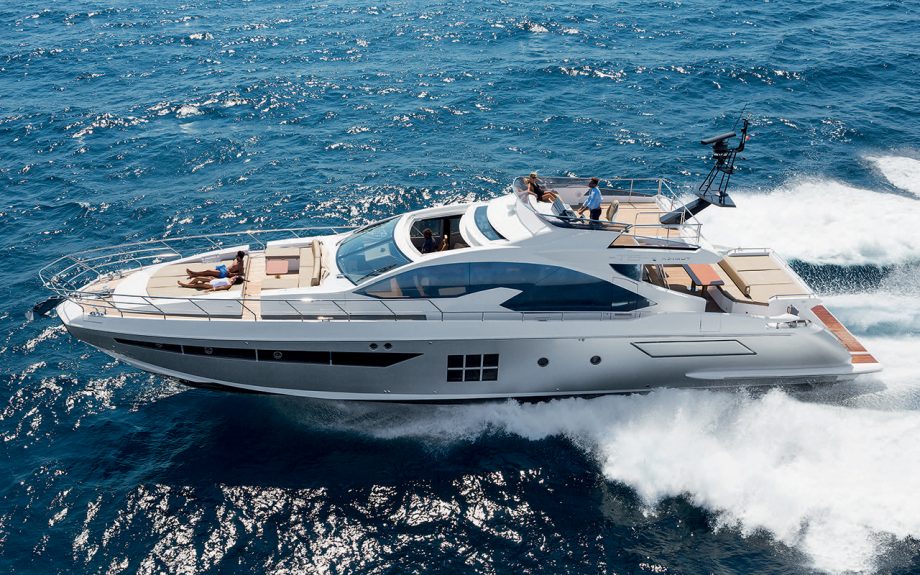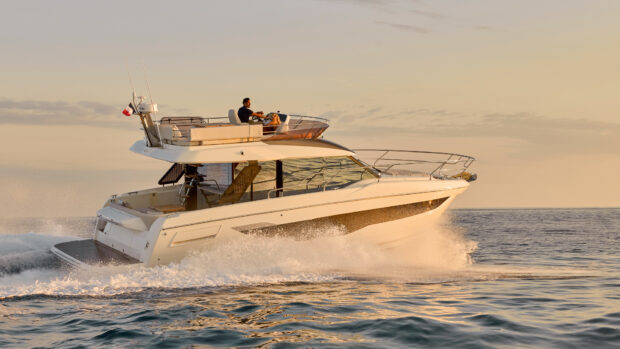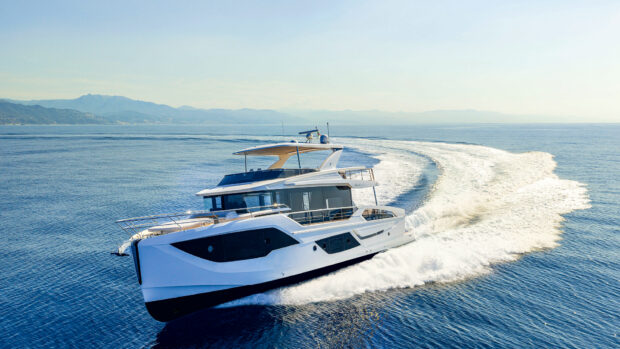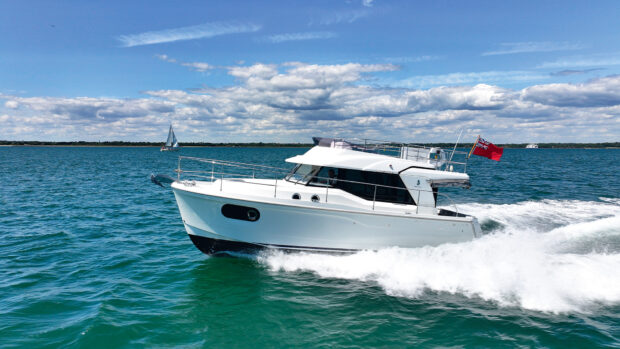For plenty of space and plenty of punch, three is the magic number on Azimut’s latest, the 77S.
When Azimut came out with their triple-engined 55S a couple of years ago, everyone thought the shipyard had lost the plot.
A glance into the claustrophobically crammed engineroom did little to dispel the notion, but after a tour of the capacious interior down below it all became clear.
Three small engines with IPS drives mean that the machinery can be set well aft, leaving lots of space for what owners really want: big beds, fab bathrooms, and room to swing several cats at once.

For privacy while in harbour there is nothing better than the foredeck seating space.
Exactly the same principle has been applied to the spectacular new Azimut 77S, which made its show debut at Cannes last autumn.
The engineroom is still crammed and claustrophobic, but avert your gaze into the 77S’s fabulous interior appointments and you’ll soon appreciate the wisdom of the concept.
The lower deck is the main beneficiary, of course, and even with two crew cabins sited just aft of midships, the master suite looks and feels exceptionally spacious, with the bathroom and dressing room aft, a dinette and dressing table, and those cool square windows framing the view like your own ever-changing art gallery.
The other cabins don’t enjoy quite the same extravagant space as the master, but when you consider that they are all ensuite, they all share headroom of at least 6ft 6in (1.98m) and they all have full-size beds and decent stowage volumes, you begin to appreciate how clever Azimut’s designers have been in shoe-horning this calibre of accommodation into a narrow, performance-oriented hull.

The owner’s suite is a masterpiece, featuring a bathroom, dressing room, dinette and dressing table, plus acres of floor space and those wonderfully cool square windows.
The interior design, by Carlo Galeazzi, is well up to Azimut’s standards. Zebrano veneers contrast with tactile leather detailing, while embossed panelling and reflective surfaces add their extra sense of quality and depth.
Welcoming in the sky
The galley is also down on the lower deck. It’s more adequate than generous, maybe, but it is very well equipped, and the decision to place it below has paid dividends upstairs, where a domestic-sized dining area and comfortable aft saloon segue smoothly through the glass cockpit bulkhead to create a genuinely impressive single-level entertaining area.
An electric awning unrolls from the overhang to shade the cockpit, while sunlight flooding into the saloon through huge side windows is complemented by an unexpected view of the sky from the helm, thanks to a sizeable sliding glass sunroof.

Dining for eight around a decent-sized table, plus it’s close to the galley just down below.
Foredeck sunbathing and seating space, complete with ‘pram-hood’ sunshade, add an extra layer of privacy when in harbour, and the excellent flybridge, although small, is another welcome surprise to discover aboard a hardtop sports yacht.
The tender storage arrangements are impressive, even though they also contribute to the frantically cramped engineroom, which with two generators as well as three engines is not a welcoming sight.
The garage can take not only a 12ft 8in (3.85m) jet-RIB tender but also a substantial PWC, while the teak-decked garage door makes an excellent relaxation area right down at water level.

Huge windows and an opening above the helm help create a vast sense of space in the saloon.
The closest equivalent in horsepower terms to the Azimut 77S’s three 13-litre, six-cylinder Volvos would be a pair of 22-litre MAN V12s, which even on V-drive gearboxes would still need a significantly longer machinery space.
There is a weight penalty in having three engines, but it’s perhaps not as severe as you might think, while Volvo’s claim that a triple installation is more fuel-efficient than an equivalent twin actually turns out to be true – although we didn’t see anything near its quoted consumption figures.
A triple IPS installation on a vessel this size is pretty cutting-edge, so we shouldn’t have been too surprised to find that on our first test, during the Cannes boat show, the engines weren’t pulling their maximum revs and the boat felt distinctly sluggish.

The Azimut 77S’s VIP cabin tucks up into the bows and has headroom of at least 6ft 6in.
A Volvo representative was summoned to explain that it had the wrong props – Q5s instead of larger-diameter, finer-pitch Q4s – and we were invited to the shipyard for another sea trial to evaluate the yacht again.
Fitting the incorrect propellers might seem to be a pretty basic error, but this was the first Azimut 77S off the line and it apparently came out about two tonnes heavier than expected. It happens.
The yacht was also pretty heavily specified, with the optional Seakeeper gyro stabilisers alone adding an extra tonne to the bottom line.

Could there be a better spot for breakfast?
So when we arrived at the yard in Savona, two weeks later, we found that Azimut’s engineers weren’t taking any chances: not only had they changed the props, they had also removed the jet-RIB tender (325kg) and the Sea-Doo (467kg) from the garage, and drained off about 700lt from the water tank (700kg).
Then we had six people aboard rather than 12, and the fuel gauges were reading less than half full, instead of the four-fifths we noted down during the show.
Driving the Azimut 77S
It certainly did the trick. The engines reached their rated maximum, and the boat felt a lot happier than it had done at Cannes, behaving beautifully and posting a top speed on a two-way average of exactly 33 knots.
Acceleration was brisk, and handling exemplary – the yacht heeled and turned with the best of them, and fulfilled that potential which is so forcefully advertised by its dramatic and masculine Stefano Righini-styling.
Just for fun, we switched off the centre engine. The massive drag of the redundant IPS obviously had a marked effect on acceleration, but the yacht heaved itself up on to the plane and eventually topped out at 23 knots. Not too bad, I thought.

For privacy while in harbour there is nothing better than the foredeck seating space.
The two sea trials with different props were very instructive, but they also demonstrated how a relatively narrow-beam hull like the Azimut 77S’s simply doesn’t have the load-carrying ability of a beamy yacht such as the Azimut 80, which on a comparable hull length is fully 28in (71cm) wider.
Azimut 77S verdict
Although it offers class-leading accommodation, with four ensuite cabins, owners nevertheless have to remember that loading the Azimut 77S up like they would a family flybridge cruiser will have a disproportionate impact on performance.
At the very least I would question whether a sports-oriented craft like this really needs the extra weight of the Seakeepers – especially since in order to appreciate the boat’s handling at its considerable best we found it necessary to turn the gyros off.
Nevertheless, Azimut appears to be on to something with its triple-IPS concept.
The obvious drawback of a cramped machinery space will be more than outweighed for the majority of owners by the internal volume on offer down below, which allows a sports yacht of relatively narrow beam to compete on equal terms with bigger boats.
Add to the mix its excellent entertaining areas and uncompromisingly cool looks, and it seems inevitable that the Azimut 77S is likely to become a familiar sight among the Med’s more chic harbours.
Lost the plot? I don’t think so. The only thing Azimut has lost is its inhibitions.
First published in the April 2015 issue of MBY.
Details
Price: €2.85 million ex VAT (approx £2.63 million inc UK VAT)
Draught: 5ft 5in (1.64m)
Fuel capacity: 924 imp gal (4,200 litres)
Water capacity: 242 imp gal (1,100 litres)
Displacement: 56 tonnes (full load)
Test engines: 3 x 900hp Volvo D13 IPS
Top speed on test: 33.0 knots
Cruising speed: 20-30 knots
Designer: Azimut










